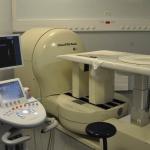
ClearPET, a new generation of PET scanners for small animals

In the prototype scanners developed by the Crystal Clear collaboration, the detector heads are based on an 8 x 8 matrix of scintillation crystal elements.read out by a multi-anode photomultiplier tube

ClearPET offers the possibility for partial detector configurations in a rotating gantry, offering high flexibility for future purposes

ClearPET's diameter can be adjusted depending on the size of the animal. A small gantry port of 125 mm is used for mice and a large of 220 mm for primates or rabbits

The ClearPETNeuro system at the Forschungszentrum Jülich. Here it is being used to image a rat's brain.

Left, the Derenzo phantom, with capillary tubes of various diameters. (b) Right, reconstructed image obtained with the ClearPETNeuro of the Forschungzentrum Jülich.

PET image showing uptake in a rat brain labelled with 18F.

Coronal slices of an oncology study on a mouse with an injection activity of 300 μCi FDG and scan duration of 14 min.

ClearPET can also be used for heart of brain studies of animals: here is an example of heart imaging using an injection dose of 750 μCi of FDG

ClearPEM-Sonic installed at Hôpital Nord, in Marseilles. Image credit: B Frisch 2011.

Each ClearPEM detector plate has modules with crystal matrices, top right, which are read out by APD arrays, bottom right.

Whole-body PET/CT and b) MRI images of a patient with multifocal breast cancer; c) coronal and d) sagittal ClearPEM views of the same breast.

The different resolutions of the various techniques (i.e. WBPET, MRI and ClearPEM) significantly improve the diagnosis and treatment of cancerous tumours by the doctor.

EndoTOFPET-US' main clinical objective is to address image-guided diagnosis and minimally invasive surgery with a miniaturized bimodal endoscopic probe with a millimetre spatial resolution and a 100 times higher sensitivity than whole-body PET scanners.

EndoTOFPET-US will allow to deal with anatomical constraints and is expected to contribute in the cases of prostatis and pancreas cancer treatment.

Endoscopic probe: A new concept of fully digital SiPM

Crystals used in the Endoscopic probe will allow a 200ps timing resolution, corresponding to a spatial resolution of 3 cm along the Line of Response (LOR) in a dual-head system.

















